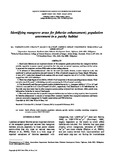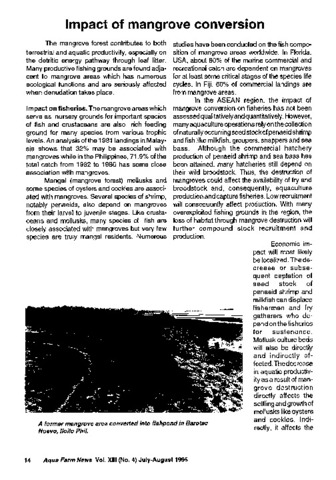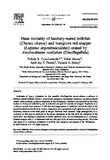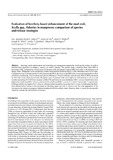Identifying mangrove areas for fisheries enhancement; population assessment in a patchy habitat
Share
Abstract
- Small-scale fisheries are an important element of the ecosystem goods and services that mangrove habitats provide, especially to poorer coastal communities that rely most on natural resources, and have similar values to payments for ecosystem services (PES) under carbon-trading schemes.
- In advance of fishery-enhancement trials for the mud crab Scylla olivacea, a mark–recapture study was conducted to estimate population size and turnover in 50 ha of isolated mangrove on Panay Island, Philippines. A total of 811 crabs were released in six sessions with an overall recapture rate of 41.5 ± 3.6%. Population size ranged from 607–1637 individuals.
- There was a high degree of site-fidelity, with 45.5% of recaptures in the same sampling areas as releases. Total mortality was 0.79 month-1, with fishing mortality accounting for 95% of overall mortality.
- Von Bertalanffy and Gompertz growth models yielded estimates for L∞ (carapace width) of 117.3 ± 14.7 and 110.6 ± 2.1 mm and for k of 2.16 ± 0.74 and 3.25 ± 0.81, respectively. Crab densities of 12–33 individuals ha-1 in the study area were lower than in other mangrove systems owing to intermittent recruitment, while growth rates indicated no limitation in terms of food supply.
- The study demonstrates that in specific mangrove habitats that are below carrying capacity, there is potential for fisheries enhancement to sustain or increase direct economic benefits from mangrove ecosystems and hence promote community engagement in broader conservation and PES initiatives.
Keywords
Ecosystem services Growth Mangroves Mark-recapture Mortality Population estimates Restocking Scylla olivacea SEAFDEC/AQD SurvivalSuggested Citation
Lebata, M. J. H., Walton, M. E., Biñas, J. B., Primavera, J., & Le Vay, L. (2012). Identifying mangrove areas for fisheries enhancement; population assessment in a patchy habitat. Aquatic Conservation: Marine and Freshwater Ecosystems , 22(5), 652-664. https://doi.org/10.1002/aqc.2235
DOI
10.1002/aqc.2235Subject
carrying capacity  ; nature conservation
; nature conservation  ; economics
; economics  ; fisheries
; fisheries  ; food
; food  ; growth rate
; growth rate  ; habitats
; habitats  ; islands
; islands  ; mangrove swamps
; mangrove swamps  ; mangroves
; mangroves  ; models
; models  ; mortality
; mortality  ; mortality causes
; mortality causes  ; natural resources
; natural resources  ; recruitment
; recruitment  ; sampling
; sampling  ; total mortality
; total mortality  ; Decapoda
; Decapoda  ; Scylla olivacea
; Scylla olivacea  ; Philippines
; Philippines  ; Philippines, Panay I.
; Philippines, Panay I.
 ; nature conservation
; nature conservation  ; economics
; economics  ; fisheries
; fisheries  ; food
; food  ; growth rate
; growth rate  ; habitats
; habitats  ; islands
; islands  ; mangrove swamps
; mangrove swamps  ; mangroves
; mangroves  ; models
; models  ; mortality
; mortality  ; mortality causes
; mortality causes  ; natural resources
; natural resources  ; recruitment
; recruitment  ; sampling
; sampling  ; total mortality
; total mortality  ; Decapoda
; Decapoda  ; Scylla olivacea
; Scylla olivacea  ; Philippines
; Philippines  ; Philippines, Panay I.
; Philippines, Panay I.
Collections
- AQD Journal Articles [1249]
Related items
Showing items related by title, author, creator and subject.
-
Impacts of mangrove conversion
Southeast Asian Fisheries Development Center, Aquaculture Department (Aquaculture Department, Southeast Asian Fisheries Development Center, 1995)The article presents the impact of mangrove conversion on fisheries and on coastal areas. The mangrove areas which serve as nursery grounds for important species of fish and crustaceans are also rich feeding ground for ... -
Mass mortality of hatchery-reared milkfish (Chanos chanos) and mangrove red snapper (Lutjanus argentimaculatus) caused by Amyloodinium ocellatum (Dinoflagellida)
Cruz-Lacierda, Erlinda R.; Maeno, Yukio; Pineda, April Joy T.; Matey, Victoria E. (Elsevier, 2004)Outbreaks of heavy infestation by the parasitic dinoflagellate Amyloodinium ocellatum in hatchery-reared milkfish (Chanos chanos) and mangrove red snapper (Lutjanus argentimaculatus) caused 100% mortality events in hatcheries ... -
Evaluation of hatchery-based enhancement of the mud crab, Scylla spp., fisheries in mangroves: comparison of species and release strategies
Lebata, Ma. Junemie Hazel L.; Le Vay, Lewis; Walton, Mark E.; Biñas, Joseph B.; Quinitio, Emilia T.; Rodriguez, Eduard M.; Primavera, Jurgenne (CSIRO Publishing, 2009)Ranching, stock enhancement and restocking are management approaches involving the release of wild or hatchery-bred organisms to enhance, conserve or restore fisheries. The present study, conducted from April 2002 to ...




